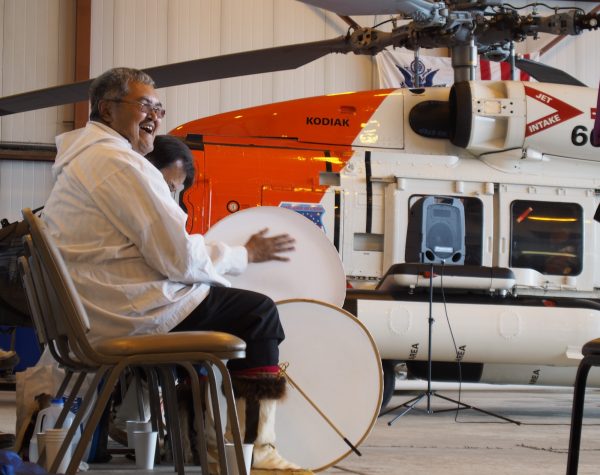
The Alaska National Guard has officially dedicated a helicopter hangar in Kotzebue to the country’s first Iñupiaq two-star general.
Major General John W. Schaeffer Jr. was head of Alaska’s National Guard from 1986 to 1991, during which time he played a critical role overseeing the guard’s response to the Exxon-Valdez spill. But long before that Schaeffer was instrumental in fighting for the people of the Northwest Arctic at a pivotal time in Alaska’s history.
On Tuesday in Kotzebue, amid the hubbub and buzz of many visitors descending on town, Governor Bill Walker stopped to chat with KOTZ radio host Johnson Greene about the day’s big affair.
“What’s on the agenda today?” Greene asked.
“Well it’s a full agenda,” Walker said. “The main event is a dedication to John Schaeffer.”
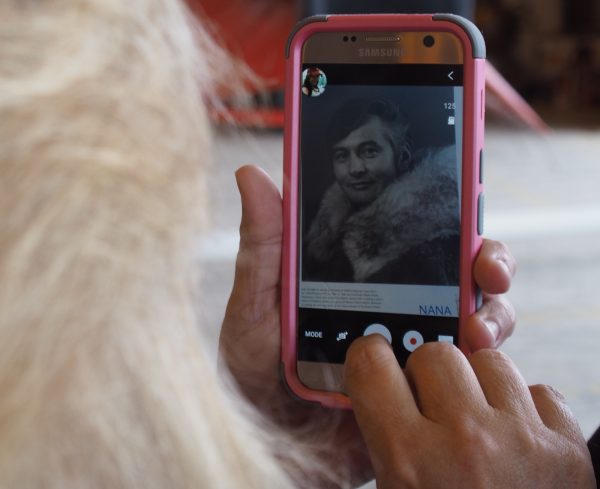
The guard is rechristening a cavernous building on the outskirts of town that holds two enormous helicopters owned by the Coast Guard, which is expanding its footprint in the Arctic. The machines and seasonal staffing are meant to increase the military’s ability to conduct operations amid growing marine traffic along the Chukchi coast. And from now on they’ll be housed inside the Qipqiña Hangar, Schaeffer’s Iñupiaq name.
Though a building dedication can seem like a minor event, that was not at all the case in Kotzebue.
Willie Goodwin read the ceremony’s invocation in Iñupiaq to more than 200 people, with all available seats filled by elders and Schaeffer family members, the walls lined with political dignitaries, military personnel, and a high school volleyball team.
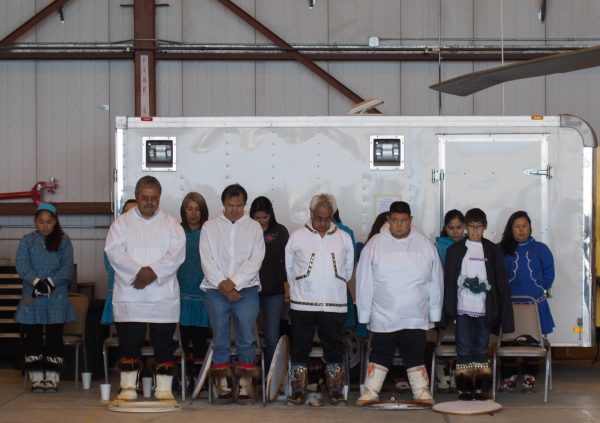
Ahead of speeches, the Northern Lights Dancers performed a song just a few feet away from where Major General Schaeffer and his wife Mary sat below the rotors of an orange helicopter. Schaeffer is in declining health, and he’s no longer able to speak.
As leaders from across the region and the state gave remarks, they were directed as much to the dozens of Schaeffer family members as to the man himself.
Former legislator and mayor of the Northwest Arctic Borough Reggie Joule spoke of Schaeffer’s legacy.
“As a young person…there was one thing I recognized: that I was walking in the shadow of giants,” Joule said, drawing tears from the crowd. “John is definitely a giant.”
Though the dedication nominally focused on Schaeffer’s military career, the day overall delved deeply into how critical a part he played building the Alaska of today, particularly across rural parts of the state. Many of the economic, cultural, and governmental institutions that impact people’s day-to-day lives started in one way or another inside John and Mary Schaeffer’s home during the sixties. And according to Joule this came at a crucial time in the formation of a political Alaska Native identity.
“We (began) to see the good of being an Iñupiaq person. That we had worth. That we were equal to all others, that we could walk alongside of them — not in front or in back,” Joule said during his remarks.
Schaeffer was a leader just as the hard political battle leading up to the Alaska Native Claims Settlement Act was being fought. And one of that effort’s architects, Willie Hensley, said his nephew John stepped up at a point when decades of oppressive policies had put Iñupiaq cultural and political power under serious threat.
Hensley drafted Schaeffer into politics while they were still in their twenties. The result, Hensley explained, was that Inupiaq values became the starting point for organizations like NANA, the school district, and the Northwest Arctic Borough in subsequent years.
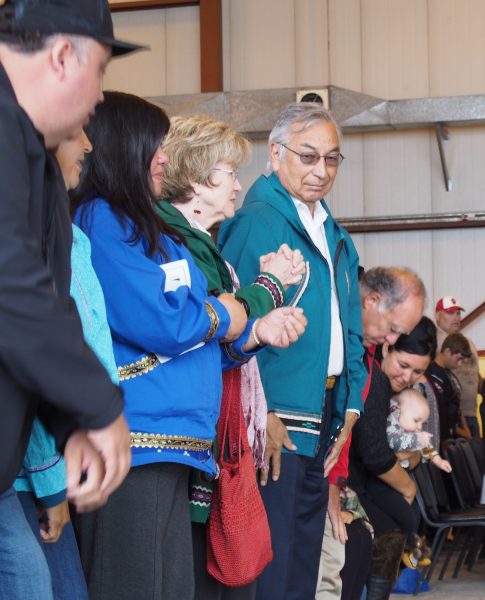
“We worked hand in glove on what we call Iñupiat Iḷitqusiat, that is, using our traditional values as a foundation of not only our individual lives, but the reason for our institutions that we worked with,” Hensley said.
The rural character to Alaska’s enduring institutions doesn’t end in the Bush. Adjutant General Laurie Hummel now leads the Alaska National Guard, just as Schaeffer once did, and sees the dedication as recognizing the values from rural Alaska that are baked into the guard.
“We are proud of his heritage and we’re proud of our heritage, because the Alaska National Guard’s roots come from the Territorial Guard,” Hummel said during an interview later in the day, not long after she participated in an invitational dance held at the end of a potluck in the guard’s armory building on the otherside of town.
The idea of naming the facility after Schaeffer came from Ron Clarke, a special assistant to Hummel, who made the case that Schaeffer embodies qualities central to both the guard and the Northwest Arctic.
“The Alaska Territorial Guard was rural based, it was community based, it was the ultimate force of citizen soldiers,” Hummel said.
Many of the Iñupiaq values Schaeffer brought to bear on the guard relate to family and community, and that legacy was evident in the dozens of relatives gathered at the hangar and potluck.
Among them was Schaeffer’s wife of almost 57 years, Mary Schaeffer.
“We were both born and raised here in Kotzebue,” she recalled, sitting on a weigh machine in a spare room of the armory.
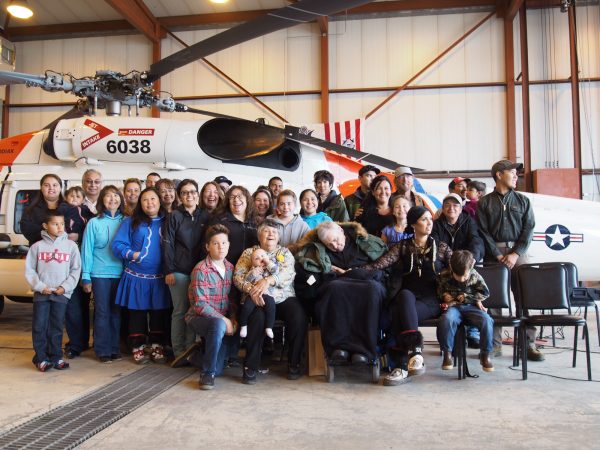
“We had our fun times in high school, then got back together—after high school,” she laughed.
The couple’s early marriage was during a time when the wives of guardsmen helped carry out essential duties. Throughout the day’s program, officials made frequent mention of the region’s women as “the back bone” of the guard’s rural presence.
Mary Schaeffer remembers when that meant carrying her young children in a sled to Kotzebue’s old armory building and waiting for the stove to heat the room before making radio calls to Nome, Barrow, and many of the communities in between.
Similiarly, the Schaeffer role in ANCSA, NANA, and the formation of the borough was a family affair.
“A lot of the work that was done,” Mary said, “was done in my kitchen.”
John’s health has worsened in the last few weeks since a bout of pneumonia and a series of small strokes. But Mary Schaeffer said she’s grateful he’s alive to see his legacy honored.

“Most of the time when…things are named, it’s usually after a person passes. And I think John understood what was happening today, because he opened his eyes and perked up a couple of times when he heard the national anthem,” Schaeffer said.
With its doors open, the Qipqiña Hanger overlooks Kotzebue, the sea, and the lands all around — the very things Schaeffer spent his life working to secure and strengthen.
Correction: an earlier version of this story mistakenly identified Mary Schaeffer as Martha.
Zachariah Hughes reports on city & state politics, arts & culture, drugs, and military affairs in Anchorage and South Central Alaska.
@ZachHughesAK About Zachariah




